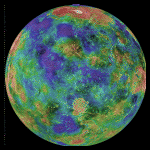 |
|||||||
| VENUS IS A BURNING-DESERT WORLD | |||||||
|---|---|---|---|---|---|---|---|
| Planet | Water | Greenhouse | Lightning | Spacecraft | Express | Transit | Resources |
 |
|||||||
| VENUS IS A BURNING-DESERT WORLD | |||||||
|---|---|---|---|---|---|---|---|
| Planet | Water | Greenhouse | Lightning | Spacecraft | Express | Transit | Resources |
The planet's black silhouette floated across the face of our star starting at 0520 UTC and continuing for six hours. WHAT IS UTC?
It was visible to many thousands of people around the world from Australia, Asia, Africa, the Middle East, Europe and eastern parts of the Americas.
Transits. In 1882, the transit of Venus and a Sun-grazing comet were recorded on photographic plates.
A transit of Venus across the face of the Sun isn't a solar eclipse. The Sun is neither blotted out nor dimmed. In fact, Venus is too small. The disk of the planet covers only 0.1 percent of the Sun.
In an unprecedented occurrence, the International Space Station (ISS) crossed the face of the Sun four times during the six-hour transit of Venus in 2004.
The next opportunities to observe a Venus transit will be June 6, 2012, and December 11, 2117.
Venus. Venus is similar to Earth. Both orbit the Sun. Venus is the second planet from the Sun and Earth is third. However, unlike Earth, Venus has no oceans. Also, Venus is hot enough to melt lead, while Earth is cool enough to support unprotected human life.
Both the U.S. and Russia have observed it with orbiters and landers from time to time since 1962.
VENUS PROBES
Safe Sun Viewing
Never look at the Sun without eye protection, no matter how tempting it may seem. Looking at the Sun can cause eye damage. Don't look at it.
Only look at the Sun through a safe solar filter. Examples might be #13 or #14 welder's glass or special eclipse glasses designed for solar viewing.
Do not use stacked sunglasses, metallized candy wrappers or compact disks. They are unsafe filters sometimes recommended in error.
Seen through a good filter, the Sun looks like a glowing disk, about the size of the Moon.
It's easier to see the Sun through a telescope, but never look at the Sun through an unfiltered telescope. Sunlight focused through a telescope can blind you instantly.
There are two ways to use a telescope safely:
- Solar projection. Point the telescope at the Sun, but do not look through the telescope or its finder scope. Instead, use shadows on the ground to align the telescope with the Sun. The shadow of a telescope will look skinniest when it is pointing directly at the Sun. Once the Sun is in the field of view, an image will shoot out of the eyepiece. Hold a white card or projection screen behind the telescope scope to see a picture of the Sun. Adjust the focus of the telescope, or else the distance between the eyepiece and the screen, until the image looks crisp and round.
- Solar filters. Cap the telescope with a suitable Sun filter that can reduce the intensity of sunlight to safe levels. Only then can you look through the eyepiece. If you're not sure which filter is safe, contact the telescope seller or manufacturer for advice. SAFE SOLAR VIEWING SOURCE: NASA
Learn more:
Venus
- Venus Planet Profile NASA JPL
- Venus Described SEDS Nine Planets
- Exploring Venus STO
- Exploring Venus index STO
- Planet Venus STO
- Venus Water STO
- Venus Greenhouse STO
- Venus Lightning STO
Venus Transit
- Venus Transit 2004 STO
- Guide to Viewing the Transit Science @ NASA
- Guide to Viewing the Transit Science @ NASA
- 2004 Venus Transit Resource Guide NASA Sun-Earth Connection
- Movies and diagrams of the transit Astronomy magazine
- Venus Transits of 2004 and 2012 NASA Goddard
- Guide to the Transit of Venus Sky & Telescope magazine
- Story of the Transit of Venus NASA Goddard
Captain James Cook
- James Cook and the Transit of Venus Science @ NASA
- James Cook and the Transit of Venus Blue Latitudes
- James Cook Journals National Library of Australia
- History of Cook's Endeavour HM Bark Endeavour Foundation
- James Cook Transit Timing Measurements Royal Society of London
- South Seas Voyaging National Library of Australia
- James Cook Drawings of 1769 Venus Transit Armagh Observatory
- Capt. Cook's Voyages Linda Hall Library History of Science
Exploring Venus and the Solar System
- Venus Spacecraft STO
- The Pioneers STO
- The Voyagers STO
- Exploring the Solar System STO
How to watch the Sun safely
- Safe Sunwatching Science @ NASA
- List of solar filter suppliers Sky & Telescope magazine
- Solar Filter Safety Sky & Telescope magazine
- Close-Up of a Star Sky & Telescope magazine
- A Beginner's Guide to Solar Observing Sky & Telescope magazine
Read more about the Solar System . . . Star: The Sun Inner Planets: Mercury Venus Earth Mars Outer Planets: Jupiter Saturn Uranus Neptune Pluto Other Bodies: Moons Asteroids Comets Beyond: Pioneers Voyagers